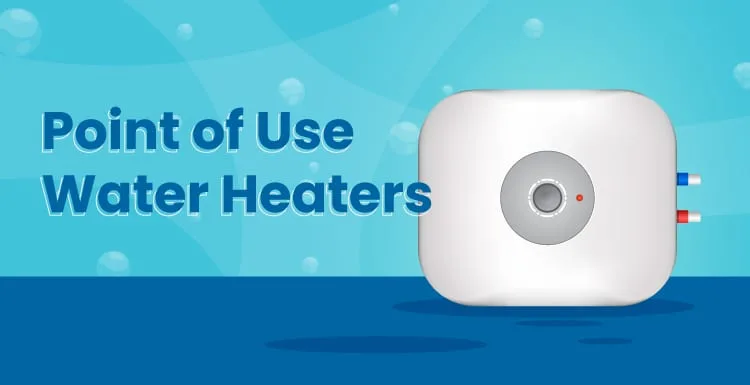Curious about what a point of use water heater does, how much it costs, or why you’d buy one of these tiny appliances?
If so, you’re in the right place.
Read on to learn all you need to know.
Considering a Point of Use Water Heater?
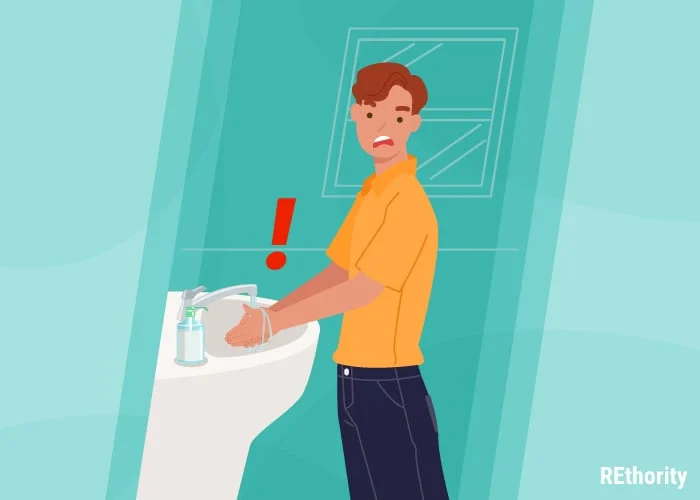 If you’re sick of waiting too long for hot water in your shower, bathtub, sink, or washing machine, you should consider a point of use (POU) water heater.
If you’re sick of waiting too long for hot water in your shower, bathtub, sink, or washing machine, you should consider a point of use (POU) water heater.
These pint-sized appliances deliver instant hot water at the faucets you use most often. They’re almost 100% efficient, have big energy cost savings, and cost a fraction of what you’d pay for a whole-house water heater.
No matter how well a storage water heater (tank-style) performs, you’ll always wait a bit for the hot water to travel through the pipes and out of the tap or faucet you’re using.
The Solution: A Point of Use Water Heater
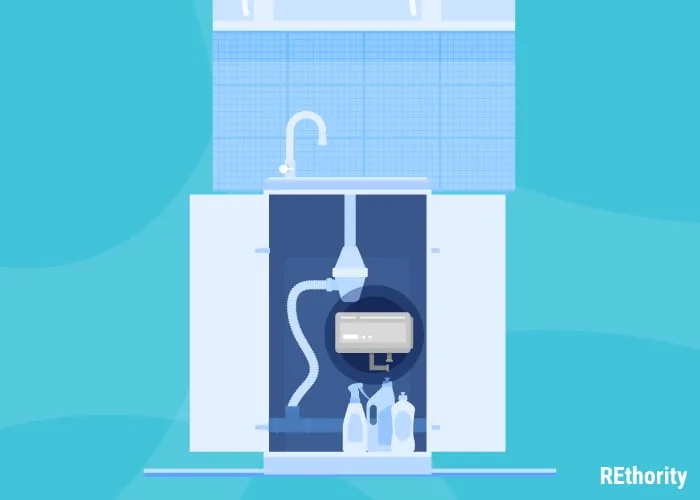
A small point of use water heater can fix this problem. Point of use water heaters work in tandem with your existing water heater by handling all of the hot water needs at a single point of use (shower, bathtub, sink, etc.) in your home.
The larger water heater handles the hot water for the rest of the house. This helps lengthen your water heater’s lifespan by allowing it to work less, putting less stress on the components.
And there’s something to be said for the underrated luxury of instant hot water the moment you turn on the tap.
Learn about point of use water heaters, the pros and cons, the installation process, average costs, and other things to consider before you buy one in our guide.
Let’s get started!
What Is a Point of Use Water Heater?
Point of use water heaters are small appliances that heat water for a specific outlet or faucet. Sometimes, a point of use water heater will serve two outlets or faucets (like a shower and the nearby sink).
These small water heaters don’t heat water for the entire house, so they tend to use less energy. Most importantly, they ensure there is always instant or nearly instant hot water available at the outlet where it’s installed.
POU water heaters can be tankless or traditional storage-style (with a tank). They are compact and are installed under the counter or on the wall.
Usually, tankless water heaters are associated with instant hot water, while tank-style models take a minute or two for the hot water to be delivered at the tap.
The Main Difference
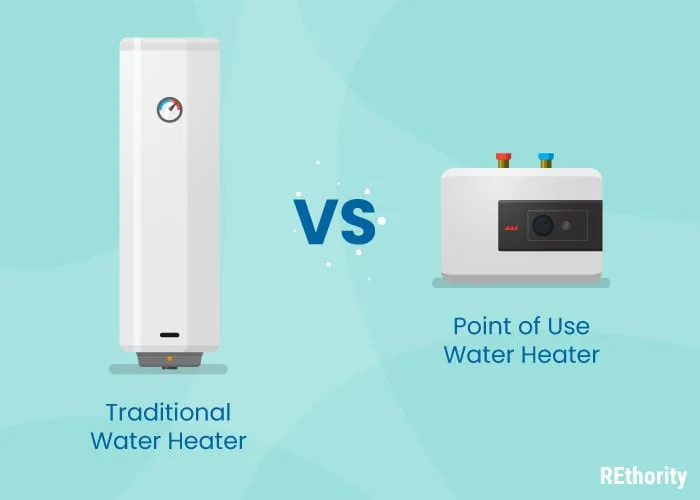
But with POU water heaters, even the smaller tank-style units can deliver instantaneous hot water because there is very little distance for the water to travel before it reaches the tap.
If you opt for a tank-style POU water heater, you’ll see models that range in size from 2.5 gallons up to 20 gallons.
For tankless POU water heaters, you’ll see models with different flow rates (which is how we measure the performance level of tankless models). We’ll cover this in greater detail later.
To start, a point of use water heater is faster and more efficient because it’s smaller and has only one job: heating water for a single (or two) water outlets.
Whole-house water heaters have a more complicated job, so they aren’t as efficient. But they still have their purpose in a home.
A whole-house unit heats water for the entire household and constantly works to refill the tank (with a traditional model) or heat more water as it’s used (with a tankless model).
Types of Point of Use Water Heaters
There are a few types of point of use water heaters on the market. Basically, you’ll choose between two fuel sources (gas or electric) and storage (tank) or tankless models.
Here’s what differs between each type:
- Gas water heaters: Gas POU water heaters require a connection to a natural gas line and venting. They feature a natural gas burner and store a limited amount of water in the tank, usually 2.5 to 20 gallons.
- Electric water heaters: Electric POU water heaters either plug into an outlet or are hardwired into the home’s wiring. They feature electric heating elements that are immersed in the water in the tank. They store a limited amount of water in the tank, usually 2.5 to 20 gallons.
- Gas tankless: Gas tankless POU water heaters require a natural gas line connection and must meet venting requirements for safety. They feature a natural gas burner and an electrical control panel, so they must be plugged into a nearby outlet. They heat water only when the hot water tap is on.
- Electric tankless: Electric tankless POU water heaters either plug into an outlet or are hardwired into the home’s wiring. They feature electric heating elements that instantly heat water only when the hot water tap is turned on.
Pros and Cons
There are some obvious benefits associated with point of use water heaters, along with a few drawbacks.
If you’re considering getting a point of use water heater, here are the pros and cons you can expect.
Pros (The Positive)
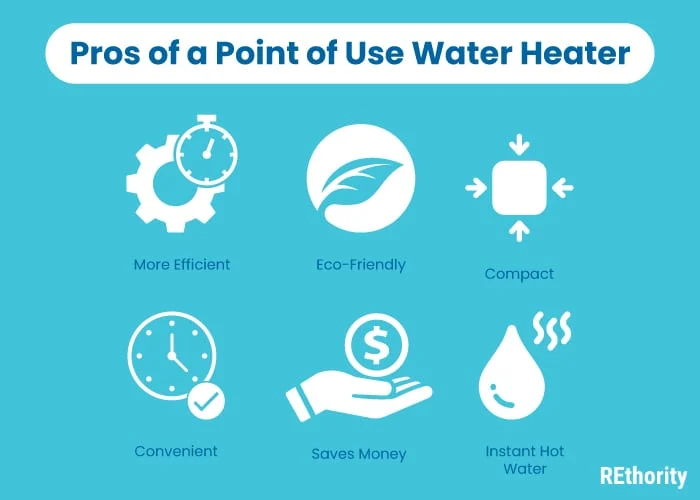
Here are several benefits and advantages you’ll notice when using a POU water heater.
More Efficient
POU water heaters remove the usual wait for hot water. Water doesn’t need to travel to the outlet because it’s heated right at the point of use. This is true for tankless and tank-style units. They’re more efficient across the board.
Eco-Friendly
POU water heaters are more eco-friendly. When you turn on a hot water tap, the cold water already in the pipe runs for a minute or two as you wait for the hot water.
This cold water goes down the drain and is wasted. Additionally, the water heater wastes energy heating that water, which then cools and later runs down the drain unused.
POU water heaters eliminate this needless waste by instantly, or nearly instantly, providing water heated to the right temperature.
Saves Money
The U.S. Department of Energy reports that homeowners can save up to 50% off their energy costs by using POU water heaters, thanks to less wasted water and reduced energy usage.
These appliances reduce utility bills, last up to 25 years, and are installed on existing plumbing (which saves money on installation costs).
Compact
You need a special, dedicated space for a large tank-style water heater, but POU models are compact and can fit just about anywhere.
Most models are designed to fit under the sink or on a wall for a smaller footprint. This makes them practical to install in any room where you want instant hot water access.
Comfort and Convenience
Immediate hot water anytime you want is a major benefit of POU water heaters. Even top-of-the-line whole house tankless models can’t compete.
By having an individual water heater installed in, say, a bathroom, you ensure that other household hot water usage (dishwasher, washing machine, etc.) doesn’t interfere with the amount of hot water you get.
It’s convenient to have plenty of hot water available where you use it most. It’s also nice that these water heaters can be installed on existing plumbing instead of requiring new lines.
Reduces Stress on Main Water Heater
Having a POU water heater reduces the amount of stress put on your main water heater and its internal components.
If you install a POU water heater in a bathroom, the main water heater no longer has to supply the hot water for showering, bathing, shaving, or hand-washing.
And because the POU water heater does its job so efficiently, you won’t see an increase in energy costs, but a decrease.
Cons (The Downside)
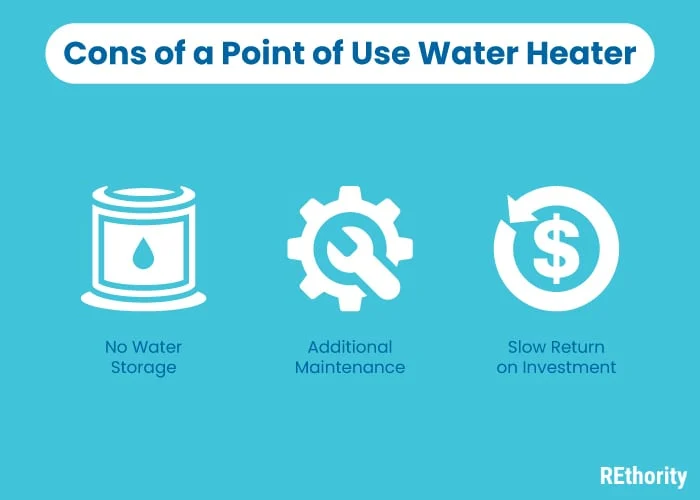
Here are a few drawbacks you might notice if you use a POU water heater.
No Hot Water Storage with Tankless Models
Tankless POU water heaters don’t store water, so if anything happens—a storm, gas or electric maintenance, etc.—the unit will be out of commission until service is restored.
Although tankless gas models use natural gas as a fuel source, they still require a connection to electricity to operate the control panel. Without electricity, a gas or electric tankless model won’t work.
With tank-style POU water heaters, you’ll at least have the hot water that is already heated in the tank if your gas or electric access is interrupted temporarily.
Additional Maintenance
If you have one or more POU water heaters, you’re looking at some additional maintenance duties. These appliances, especially tankless models, are prone to mineral buildup.
Some tankless models will automatically shut down if they detect an excess buildup of sediment. In areas with hard water, this can become a headache.
2+ Years to Pay for Itself in Energy Savings
You will save money on your energy costs with a POU water heater, but the upfront cost of around $150 has to be factored in.
If you save about $75 each year (data from Consumer Reports) on utility costs with a POU water heater, it will take you two years to recoup the cost.
This isn’t a bad tradeoff, but don’t expect a POU water heater to pay for itself right away.
Factors To Consider
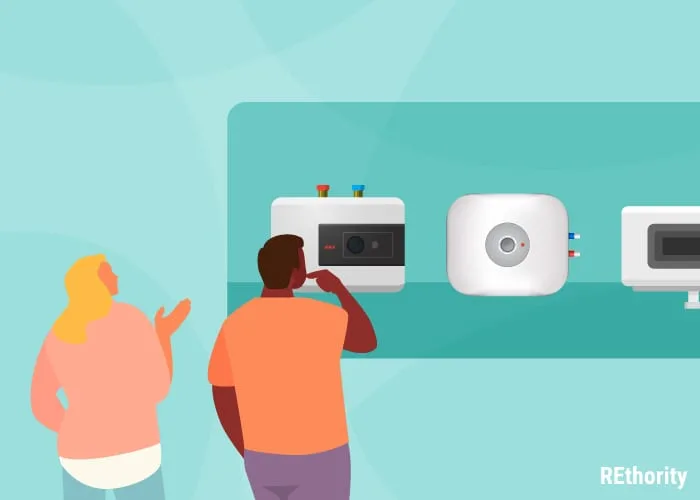
It can be difficult to choose the point of use water heater that will meet your needs.
After all, there are so many specifications, energy guide labels, fuel sources, brands, and models that even an expert has to do some calculations to choose the best.
But in this case, an expert is exactly what you should seek out. By letting a professional know what you’re looking for, they’ll be able to recommend the right unit for your needs.
Professionals will consider your household size, how much hot water you’ll need in the area where you want to install the water heater, your ideal flow rate, and more.
Size vs Use
They’ll consider how many BTUs (for gas models), the tank size needed (for storage models), and your average level of usage per day at that water outlet.
They’ll use estimated gallons per minute (GPM) and first-hour delivery (FHD) rates to find the POU water heater that can meet your needs.
For example, the average shower in the United States takes about 17 gallons of water and lasts about 8 minutes.
If you were looking for a tankless unit, a professional would recommend that you get one with 2.5+ GPM (gallons per minute) to ensure there’s always plenty of hot water at that tap.
Flow Rates
If you’re choosing to have a POU water heater installed in a kitchen, half-bath, or laundry room, there are other flow rates to consider. For example, a bathroom faucet tends to use about 1 GPM, while a kitchen sink is closer to 1.5 GPM.
A dishwasher can be as much as 2.5 GPM, and a washing machine or bathtub can be as much as 4 GPM.
The location of your POU water heater and the water fixtures’ flow rates are things your plumber will consider for you. Rely on the expertise of someone who knows this information and can help you make the right decision.
The form we’ve included in this guide will help you connect with a professional plumber in your area to choose the right unit and get it properly installed.
How to Install a Point of Use Water Heater
Installing a POU water heater is not a simple DIY job. It can be dangerous if you don’t know what you’re doing.
Plumbing connections, gas line connections, gas venting and exhaust, dangerous amounts of electrical current, and special equipment requirements make water heater installation one job you should leave to the pros.
If you don’t have a go-to plumber, use our form to find one in your area that is highly rated and experienced.
Just enter your basic information and describe what you’re looking for briefly to get a reply from a plumber near you along with a free quote for service. There are no obligations to accept a quote or move forward.
Our form is just a way to find a trustworthy plumber in your area and get an idea of how much you’ll pay for the water heater and installation.
Save your DIY skills for another project and give an expert a call for POU water heater installation. It’s the safest and most efficient option.
Where to Install a Point of Use Water Heater
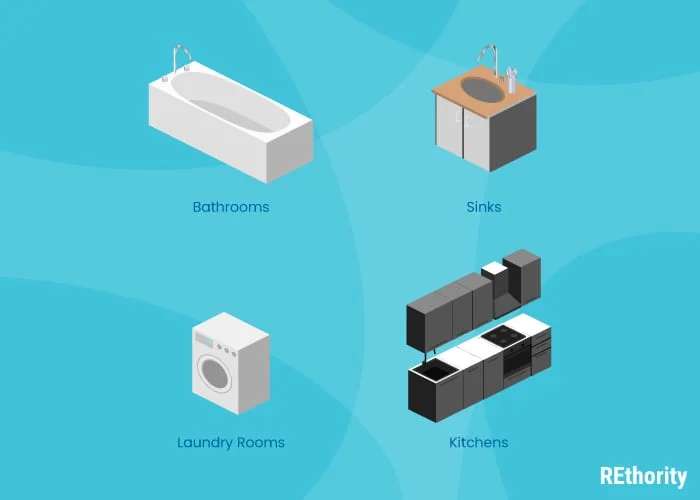
When you speak with a professional about your point of use water heater, you’ll want to know where you would like it installed.
Where is your heaviest hot water usage?
For some, it’s the washing machine or dishwasher. Others will find that it’s a specific bathroom. Here are the most common locations for POU water heaters.
Bathrooms
Hot showers anytime, day or night, are a pretty tempting notion. Installing a POU water heater in a bathroom where lots of showers are taken can dramatically increase your main water heater’s efficiency.
It may also reduce your utility bills and ensure no one runs out of hot water during their shower.
The best part?
As soon as you turn the tap on, the water is at the perfect temperature with no wait.
Sinks
Some units are connected to more than one fixture (like a shower and a sink), but if you have a half-bath or just want to put the sink on the POU water heater, you can ensure there’s 24/7 instant hot water for washing hands, shaving, brushing teeth, face washing, and more.
Kitchens
You probably have two outlets in your kitchen that both use quite a bit of hot water: the dishwasher and the kitchen sink. Dishwashers can use up to 2.5 GPM, and your kitchen sink may use 1.5 GPM.
To keep your dishwasher and kitchen sink from reducing the amount of hot water or flow available for showers, hand washing, and more, you can put the dishwasher and kitchen sink on a POU water heater.
This ensures the water is always hot enough to sanitize the dishwasher and sink. In some cases, it helps you avoid buying an expensive replacement whole-house unit.
Laundry Rooms
Washing machines use a lot of hot water, up to 4 GPM. With a washing machine running, there may be less hot water available for other uses in your house.
By putting a POU water heater next to your washing machine, you ensure there’s a dedicated water heater for it without interfering with your other hot water uses.
It also makes sure the hot water never runs out for your washing machine, so your clothes reach a sanitized temperature in the wash and come out fresh and clean.
How Much Are Point of Use Water Heaters?
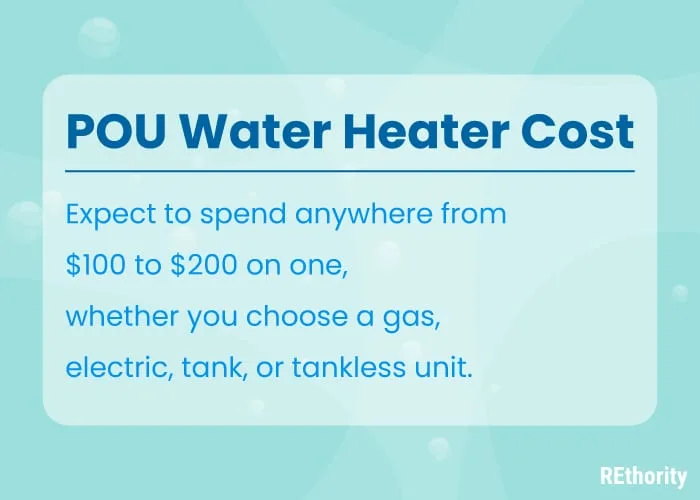
Point of use water heaters are much less expensive than their larger whole-house counterparts. You can usually expect to spend anywhere from $100 to $200 on one, whether you choose a gas, electric, tank, or tankless unit.
In addition to the cost of the water heater itself, you will need to pay a professional to install it for you. Plumber rates vary widely according to your location, average rates in your area, type and length of installation, and more.
Do keep in mind that average plumber hourly rates start at about $45 per hour. You may pay less or more, depending on the above factors.
If you purchase a POU water heater for $150 and it takes a plumber 2 hours to install it at a rate of $75/hour, the entire thing might cost you $300. For instant hot water where you need it, it’s not a bad price!
Connect With a Pro Now
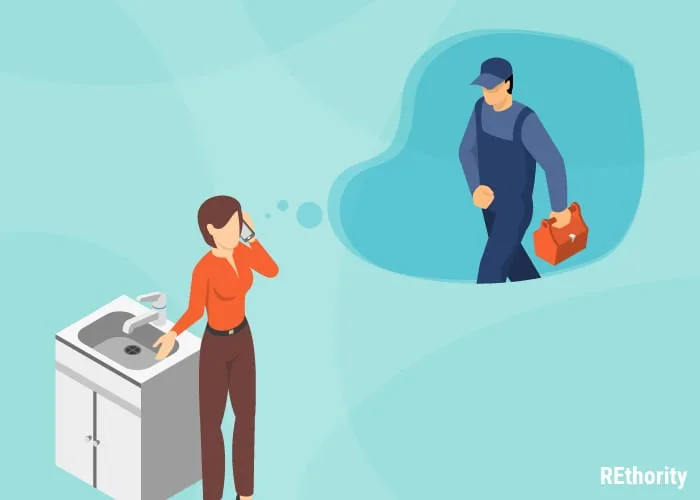
It’s always a good idea to invest a little into a point of use water heater. These small appliances can make a big difference in your overall energy costs.
They’re eco-friendly, affordable, compact, and more efficient than relying on a single water heater for the whole house. They make lukewarm showers and running out of hot water a thing of the past.
Once you determine where you want your POU water heater installed and which type you want (gas, electric, tank, tankless), just contact a pro for installation.
The installation doesn’t take long with a professional, and you can be sure it’s done safely and to code. You’ll be all set.
Use our included form to find a professional plumber you can trust in your area. You’ll get a free quote so you can have a better idea of how much you’ll pay for installation – and you’ll know it’s done right.

